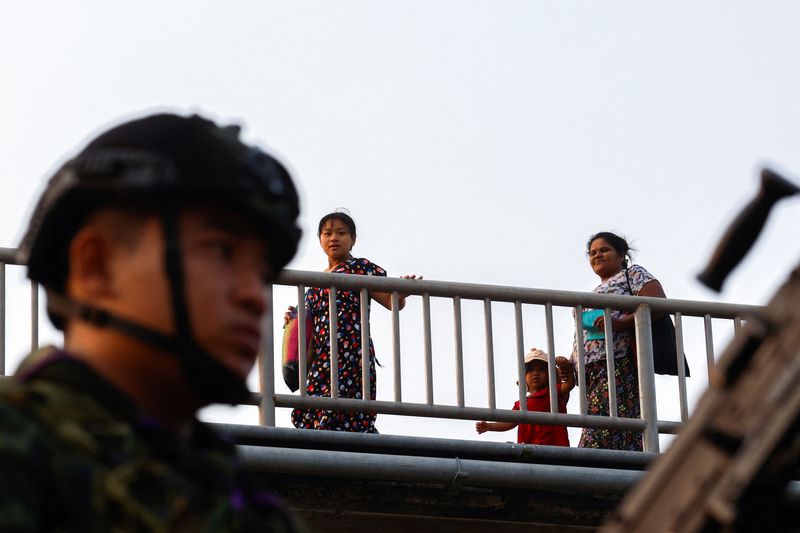By Panu Wongcha-um
MAE SOT, Thailand (Reuters) – Hundreds of refugees crossed the river border between Myanmar and Thailand on Friday after a strategic border town fell to rebels fighting Myanmar’s military junta.
Some said they feared airstrikes by the Myanmar military after the rebels took Myawaddy, a city of about 200,000 people located across the Moei River from the Thai town of Mae Sot.
“That’s why I fled here. They can’t bomb Thailand,” said one woman, Moe Moe Thet San, a Myawaddy resident, who was queuing with dozens of people at a border checkpoint in the heat. She had crossed the border with her little son.
Thailand’s foreign minister said on Friday his government was preparing for the influx of refugees and called on Myanmar’s junta to curb the violence.
Thailand is also working with members of the Association of Southeast Asian Nations (ASEAN) to revive a stalled peace plan for Myanmar, Parnpree Bahiddha-Nukara said.
“It is our neighboring country and we do not want to see violence,” Parnpree told reporters after a visit to Mae Sot. “We want them to talk to each other. They can use us as a broker if they want.”
Myawaddy was wrested from military control on Thursday by anti-junta forces led by the Karen National Union (KNU) rebel group.
Thailand is considering alternative trade routes in case there are road closures due to the fighting, Parnpree said.
A group of fewer than 200 junta soldiers who retreated from their base to the Thai border earlier this week were still in the area and Thai authorities had not yet received any requests from them to cross, Parnpree said.
“They must put down their weapons and put on civilian clothes before we allow them to cross the border,” he said.
Junta spokesman Zaw Min Tun told Myanmar media that some of his troops left their base because they were accompanied by their families. Negotiations are underway with Thailand, he said.
It was not immediately clear which group of junta soldiers he was referring to and he did not return a call from Reuters seeking comment.
Myanmar has been in turmoil since 2021, when the powerful military ousted an elected civilian government and sparked widespread protests that it sought to crush with violence.
Simmering anger against the junta grew into a nationwide armed resistance movement that is now increasingly operating in coordination with established ethnic rebel groups to challenge the military across much of Myanmar.
“Fear of air raids”
On Friday, amid tight security on the Thai side, a steady stream of people fleeing Myanmar lined up at a border crossing, including vehicles armed with machine guns, overlooking the Moei River.
“I’m afraid of airstrikes,” said 39-year-old Moe Moe Thet San. “They made very loud noises that shook my house.”
The loss of Myawaddy deprives the junta, already struggling with an economy in free fall, of vital revenue from border trade while strengthening rebel groups, analysts say.
Myanmar’s military could still try to launch a counterattack with support from its air force to retake the city, said Dulyapak Preecharush, an associate professor of Southeast Asian studies at Thammasat University in Bangkok.
“So there is a question about a possible intensification of fighting in the coming days,” he told Reuters.
On Thursday, Thai Prime Minister Srettha Thavisin said fighting in Myanmar should not spill into his country’s airspace.
In an interview with Reuters last week, Srettha said Myanmar’s junta was “losing strength” as he pushed for talks to begin with the military government.
Thailand, which says it remains neutral in the Myanmar conflict and can host up to 100,000 people displaced by it, has continued engagements, including aid deliveries, with its neighbor since Srettha took power last August.
(Reporting by Panu Wongcha-um in Mae Sot and Reuters staff; Writing by Devjyot Ghoshal; Editing by Clarence Fernandez, Kanupriya Kapoor and Angus MacSwan)
